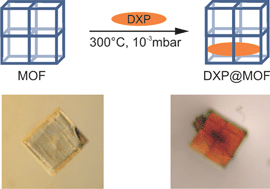Highly emissive metal–organic framework composites by host–guest chemistry†
Abstract
The unique

* Corresponding authors
a
Chair of Inorganic Chemistry II – Organometallics and Materials Chemistry, Ruhr-Universität Bochum, Bochum, Germany
E-mail:
roland.fischer@rub.de
Fax: +49 (0)234 32-14174
Tel: +49 (0)234 32-24174
b
Physical Institute and Center for Nanotechnology, CeNTech, Westfälische Wilhelms-Universität Münster, Münster, Germany
E-mail:
decola@uni-muenster.de
Fax: +49 (0)251 980-2834
Tel: +49 (0)251 980-2873
The unique

 Please wait while we load your content...
Something went wrong. Try again?
Please wait while we load your content...
Something went wrong. Try again?
M. Müller, A. Devaux, C. Yang, L. De Cola and R. A. Fischer, Photochem. Photobiol. Sci., 2010, 9, 846 DOI: 10.1039/C0PP00070A
To request permission to reproduce material from this article, please go to the Copyright Clearance Center request page.
If you are an author contributing to an RSC publication, you do not need to request permission provided correct acknowledgement is given.
If you are the author of this article, you do not need to request permission to reproduce figures and diagrams provided correct acknowledgement is given. If you want to reproduce the whole article in a third-party publication (excluding your thesis/dissertation for which permission is not required) please go to the Copyright Clearance Center request page.
Read more about how to correctly acknowledge RSC content.
 Fetching data from CrossRef.
Fetching data from CrossRef.
This may take some time to load.
Loading related content
